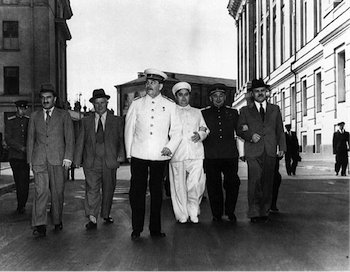

|
The Struggle for Power  From left: Mikoyan, Khrushchev, Stalin, Malenkov, Beria, Molotov A collective leadership assumed control on 5 March. It marked a return to Leninist principles, but was also a reflection of divisions in the leadership. The Politburo was divided over whether to continue Stalin's policies or introduce reforms, and these differences were complicated by personal rivalries. Beria was the dominant figure. With his power base in the MVD and MGB, he ran the government with Georgii Malenkov (Chairman of the Council of Ministers) and Voroshilov (Chairman of the Presidium of the Supreme Soviet). But Khrushchev (Secretary of the Central Committee) was bitterly opposed to Beria and campaigned against him with Nikolai Bulganin (Defence Minister). Senior Party and military leaders were suspicious of Beria's programme, which involved the immediate dismantling of the Gulag system and the relaxation of Soviet policies in the newly-annexed territories of western Ukraine, the Baltic region and East Germany. Beria imposed a series of reforms on the East German leadership in the spring of 1953. The Communist hardliners in Berlin dragged their heels over implementing the measures, resulting in mass demonstrations on the streets of East Berlin on 16-17 June. Back in Moscow, Beria was blamed for the uprising by Khrushchev, Bulganin, Molotov and even Malenkov. On 26 June, Beria was arrested in a Kremlin coup organized by Khrushchev with senior army personnel in the Soviet capital. He was tried in secret and then shot in December 1953. None of the leaders opposed the coup. Trained in the traditions of Stalinist obedience, they were a docile group of functionaries, quick to bend their principles when they sensed a shift of power at the top. |
© 2014 Orlando Figes | All Rights Reserved